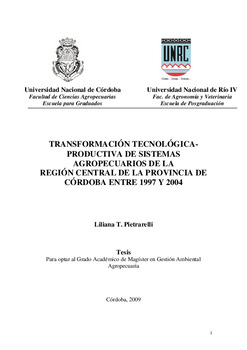| dc.contributor.advisor | Cáceres, Daniel Mario | |
| dc.contributor.author | Pietrarelli, Liliana Teresa | |
| dc.date.accessioned | 2021-05-07T00:15:13Z | |
| dc.date.available | 2021-05-07T00:15:13Z | |
| dc.date.issued | 2009 | |
| dc.identifier.uri | http://hdl.handle.net/11086/18170 | |
| dc.description | Tesis (Magíster en Gestión Ambiental Agropecuaria) – UNC - Facultad de Ciencias Agropecuarias; UNRC - Facultad de Agronomía y Veterinaria, 2009. | es |
| dc.description.abstract | La presente tesis se propone caracterizar, analizar y evaluar las transformaciones tecnológico-productivas de sistemas de producción de la zona semiárida central de la Provincia de Córdoba (Argentina) y su vinculación con procesos estructurales que ocurrieron en la región en dos momentos con contextos socioeconómicos diferentes: las campañas 1997-1998 y 2003-2004. Se compararon un conjunto de variables e índices que permitieron comprender las transformaciones observadas en la estructura y dinámica de los sistemas estudiados y evaluar los principales procesos de cambio.
A partir de entrevistas semiestucturadas realizadas a 40 productores agropecuarios, se recabó información sobre la estructura de sus sistemas agropecuarios, el uso espacial y temporal de la tierra, el manejo del suelo, el tipo de control de factores bióticos adversos, el grado de utilización de insumos productivos y el destino de sus inversiones. Para la comparación de los dos momentos se utilizaron variables relevantes y se construyeron índices específicos, los que fueron analizados utilizando estadística descriptiva y técnicas multivariadas.
Los resultados sugieren que estos sistemas productivos han sufrido importantes cambios en su estructura y dinámica, los que se manifiestan a través de procesos de simplificación (i.e., disminución de número de rubros), intensificación (i.e., uso creciente de insumos productivos) y extensificación (i.e., aumento de la escala productiva). El mayor peso relativo de la agricultura constituye la principal transformación observada en su diseño productivo. Esto ocurrió en el marco de condiciones macroeconómicas que favorecían la agriculturización, en particular la expansión de la soja y el doble cultivo trigo-soja. Los cambios tecnológico-productivos fueron incorporados en forma diferencial según el grado de agriculturización que tenían las explotaciones durante la campaña 1997/98. Los sistemas mixtos fueron los que adoptaron más tardíamente el paquete tecnológico siembra directa-soja RR. No obstante, fueron los que más profundamente modificaron su diseño productivo. En los distintos tipos de sistemas estudiados se constató una marcada homogeneización productiva y una fuerte adopción del paquete tecnológico dominante. | es |
| dc.description.abstract | This thesis aims to characterize, analyse and evaluate the technological and productive transformations of farming systems located at the central-semiarid area of Province of Córdoba (Argentina); and their relationships with more global processes that occurred in the area in two periods with different socio-economic features: farming seasons: 1997-1998 and 2003-2004. A set of variables and indexes were developed and analised in order to understand the changes on farms’ structure and dynamics, and to evaluate the main socio-productive processes.
Using a semi-structured questionnaire, 40 farmers were interviewed. This allowed gathering information about productive-systems structure, spatial and temporal land use, soil management, weed and pest control, use of external inputs, and investment destination. The variables and indexes developed were used to compare the two moments studied and analysed using descriptive and multivariate statistics.
The main results suggest that the farming systems show important changes in their structure and dynamics. Simplification (i.e., decrease in the number of productive activities), intensification (i.e., incresing use of external inputs), and extensification (i.e., increase in farm size, or productive scale). These changes ocurred within a macroeconomic scenario that favoured the expansion of agriculture, in particular soybeans cultivation and wheat-soybean double crop. The main transformation observed in the farms was the increase of the area devoted to grain crops. Technological changes were incorporated by farmers at a different pace, depending on the percentage of crop grains being cultivated in the 1997-1998. The adoption zero tilling and GMO seeds, takes place later in mixed production systems. However, theese farms showed the greater transformations in their productive design. Farm homogenisation followed the principles of modern agriculture and the adoption of the dominant technological packages. | en |
| dc.format.extent | 133 h. : il. col. | es |
| dc.language.iso | spa | es |
| dc.rights | Attribution-NonCommercial-NoDerivatives 4.0 Internacional | * |
| dc.rights.uri | http://creativecommons.org/licenses/by-nc-nd/4.0/ | * |
| dc.subject | Sistemas de producción | es |
| dc.subject | Estructura agrícola | es |
| dc.subject | Cambio tecnológico | es |
| dc.subject | Córdoba | es |
| dc.subject | Argentina | es |
| dc.title | Transformación tecnológica-productiva de sistemas agropecuarios de la región central de la Provincia de Córdoba entre 1997 y 2004 | es |
| dc.type | masterThesis | es |
| dc.description.fil | Pietrarelli, Liliana Teresa. Universidad Nacional de Córdoba. Facultad de Ciencias Agropecuarias; Argentina. | es |
| dc.description.fil | Cáceres, Daniel Mario. Universidad Nacional de Córdoba. Facultad de Ciencias Agropecuarias; Argentina. | es |





